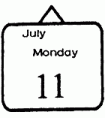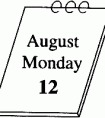仔细看日历,填空。1.—Whatdayisit? —It'sMonday,July .2.—What ? —It's .3. —W? —.4. —W?— .5. —W ? — .6. —W?— .-四年级英语
1800年读作 eighteen hundred
(3) 十位数字上为“零”,该“零”读为字母O的发音。
1809年读作 eighteen O nine
(4) 关于千年的一些读法。
2000年读作 two thousand 或 twenty hundred
2008年读作 two thousand and eight 或 twenty O eight
1008年读作 one thousand and eight 或ten O eight
(5) 三位以内数字的年份,它们有两种读法:一种是按照基数词的方法来读,另一种是一个一个数字来读。
531 BC 读作 five three one BC /five hundred and thirty-one BC
二、日期
日期的写法可以采用基数词和序数词两种形式。
例如: March 1也可以写成March 1st;May 29也可以写成May 29th。
但是,日期的读法只能用序数词的形式。例如:
October 31(October 31st)读作October(the)thirty-first
August 26(August 26th)读作August(the)twenty-sixth
三、月份表达:
January n. 一月,正月(略写为Jan.)
February n. 二月(略写为Feb.)
March n. 三月(略写为Mar.)
April n. 四月(略写为Apr.)【引申】April Fool’s Day愚人节(每年的四月一日)。
May/mei/ n. 五月
June n. 六月(略写为Jun.)【记忆法】由罗马神话中婚姻女神朱诺Juno而得名。
July n. 七月(略写为Jul.) 【记忆法】由于罗马将军尤里乌斯?凯撒Julius Caesar生于七月,而得名。
August n. 八月(略写为Aug.) 【引申】此词源自罗马第一位皇帝奥古斯都Augustus的名字。
September n. 九月(略写为Sept.)【记忆法】September源自拉丁文的“7”sept,在早期的罗马历中为7月,后因历法的修正而成为9月。
October n. 十月(略写为Oct.)
November n. 十一月(略写为Nov.)
December n. 十二月(略写为Dec.)
1. 年代前用in。如:in 1999
2. 表示月份的单词首字母要大写,表示在某月用in。如:in March
英语中月份和星期名称都是专有名词,它们的首字母必须大写,并且前面无需用冠词。
在某月,用介词in,注意月份前不加冠词。
具体日期前面要用on. 四月一日-----onApril1st.
3. 日期前必须加the ,日期用序数词表示;表示在某日用介词on。
如:on September the first (在九月一日) / on September 1st
英语表达:日+月+年【日期序数词+月份,年份】
美语表达:月+日+年【月份+日期序数词,年份】
如一九九六年三月二日的写法:
2nd March, 1996(英)
March 2, 1996(美)
在美式的写法中,1st, 2nd, 3rd的st, nd, rd是不使用的。由于日期书面表达不同,读法也不一样。
如1987年4月20日,英式的写法是20th April, 1987,读成the twentieth of April, nineteen eighty-seven;
美式的表达是April 20, 1987,则读成April the twentieth, nineteen eighty-seven。
同样,全部用数字表达日期时,英美也有差别。1998年5月6日按照英国式应写成6/5/98,而按照美国式应写成5/6/98;
01.08.1998是英国式的1998年8月1日,按照美国的表达方式却是1998年1月8日,美国的1998年8月1日应写成08,01,1998。
考点名称:特殊疑问句
- 特殊疑问句:
以特殊疑问词开头,对句中某一成分提问的句子叫特殊疑问句。
常用的疑问词有:what、who、whose、which、when、where、how、why等。
特殊疑问句往往是就其中的某一成分,进行提问,而且根据情况直接回答,不能用yes或no简单回答。
常见的疑问代词有who, whose, which, what;疑问副词有when, where, why, how。
例:What do you do on Sunday? 你周日的时候干什么?
Which class are you in? 你在哪个班?
Where does Mr. Li live? 李先生住在哪?
Why are you late? 你为什么迟到? 特殊疑问句的构成:
一、 特殊的疑问词。
特殊疑问句要由疑问代词或疑问副词开头,询问的内容不同, 使用的疑问词也不同。
我们学过的疑问词有:
what(询问事物), how much(询问价格),what time (询问时间,尤其是点钟), what kind of(询问种类),why(询问原因),who(询问人), where(询问地点) 等等。如:
—What is this? 这是什么?
—It's a key. 这是一把钥匙。
—How much is it? 这个多少钱?
—It's twenty dollars. 二十美元。
—What kind of movies do you like? 你喜欢哪一类型的电影?
—I like action movies. 我喜欢动作片。
二、特殊的语序。
特殊疑问句由疑问词开头,其构成是“疑问词 + 一般疑问句”。如:
What time is it? 现在几点钟?
Who is your teacher? 谁是你的老师?
三、特殊的答语。
特殊疑问句不能用yes, no来回答,而应根据它所询问的内容直接做出回答才行。如:
— What time is it, please? 请问几点了?
— It's 7:30. 七点半了。
— Where are they? 他们在哪儿?
—They're in the playground. 他们在操场上。
—What's your favorite subject? 你最喜爱的科目是什么?
—English. 英语。
四、 特殊的语调。
一般情况下,特殊疑问句要用降调(↘)来读。如:
Who's ↘that?
How old is↘Jack?特殊疑问句有两种语序:
1.如疑问词作主语或主语的定语,即对主语或主语的定语提问,其语序是陈述句的语序:
Who is singing in the room﹖
whose bike is broken﹖
2.如疑问词作其他成分,即对其他成分提问,其语序是:
特殊疑问词+一般疑问句【特殊疑问词+be/助动词/情态动词+主语+谓语】
What does she like?
What class are you in﹖
Where are you from﹖
What time does he get up every morning﹖
How do you know﹖- 就划线部分提问的基本方法:
小学对特殊疑问句的考查主要采取对划线句子提问的方式,那么在句型转换就划线部分提问的基本方法是:
先根据划线部分词语的意思和句法功能确定用什么疑问词;
然后将原句变为一般疑问句跟在疑问词的后面即可(注意去掉划线部分)。
基本构成:疑问词+一般疑问句
A、对“物”划线用What。
This is an orange. → What is this?
We can see a cat under the desk. → What can you see under the desk?
B、对“地点”划线用Where,如果“地点”作定语时,用Which后跟被修饰的那个名词。
He is under the tree. → Where is he?
Jenny is in the classroom. → Where is Jenny?
C、对“年龄”划线用How old。
Miss Li is twenty-three. → How old is Miss Li?
My sister is five years old. → How old is your sister?
D、对“颜色”划线,用What colour。
Her sweater is red. → What colour is her sweater?
E、对“可数名词的数量”划线用How many +复数名词。
She has one red coat. → How many red coats does she have?
I have six books. → How many books do you have?
F、对“不可数名词的数量”划线用How much+不可数名词。
I want to buy three kilos of meat. →How much meat do you want to buy?
G、对“职业”划线用What。
She is a driver. → What is she?
My father is a farmer. → What is your father?
H、对“星期几”划线用What day。
It's Sunday today. → What day is it today?
I、对“时间”划线用What time。
We go to school at seven in the morning. → What time do you go to school in the morning?
It is five o’clock now. → What time is it?
- 最新内容
- 相关内容
- 网友推荐
- 图文推荐
| [家长教育] 孩子为什么会和父母感情疏离? (2019-07-14) |
| [教师分享] 给远方姐姐的一封信 (2018-11-07) |
| [教师分享] 伸缩门 (2018-11-07) |
| [教师分享] 回家乡 (2018-11-07) |
| [教师分享] 是风味也是人间 (2018-11-07) |
| [教师分享] 一句格言的启示 (2018-11-07) |
| [教师分享] 无规矩不成方圆 (2018-11-07) |
| [教师分享] 第十届全国教育名家论坛有感(二) (2018-11-07) |
| [教师分享] 贪玩的小狗 (2018-11-07) |
| [教师分享] 未命名文章 (2018-11-07) |

![Today is Thursday, October ____________.[ ]A.foruthB.forthC.fourth-五年级英语](http://www.00-edu.com/d/file/ks/4/1/17/2019-08-14/smallfad5032b3be6f7cbf122a764f4a846621565790833.png)



![根据图片,选择正确答语。—What's the date?—_____________[ ]A.March thirtiethB.July thirtieth-四年级英语](http://www.00-edu.com/d/file/ks/4/1/17/2019-08-14/small3b84e0d587fae635dfc910ef8450a67f1565790766.png)
